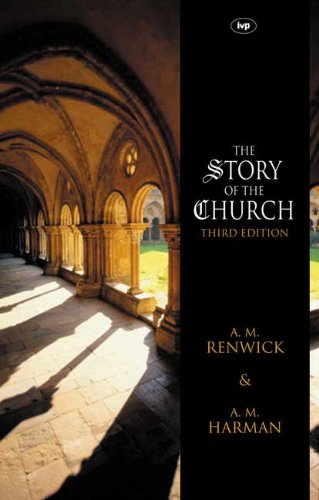The Story of the Church
Written by A.M. Renwick and A.M. Harman, Reviewed By D.W. BebbingtonThere is a constant need for a short, straightforward, single-volume history of the church in paperback, designed for the Christian in the pew who wishes to understand the past of die faith. For forty years A.M. Renwick’s book has honourably fulfilled that role, going through no fewer than twenty-four reprintings. It sets out to account for the success of the church in carrying out the great commission, and so it is moulded by a distinctly Evangelical way of looking at the world—but the issue it addresses is the one that, even in non-Christian terms, is probably the most important question to pose. Why has Christianity proved so enduringly successful in spreading? The original author, who wrote chapters 1 to 21 covering the whole field down to the nineteenth century, was the Professor of Church History at the Free Church College in Edinburgh. The writer of the supplementary chapters 22 to 24, first issued in 1985, and of chapter 25, now published for the first time, is the son-in-law of his predecessor and the Principal of the Presbyterian Theological College in Melbourne. He has also added a fine short list of basic books for further reading and has brought the story entirely up-to-date with mention of John Wimber and even the consequences of the handover of Hong Kong to China. The book will no doubt continue to play a part in propagating an appreciation of the Christian past, but it has to be said that it is showing its age. There are a number of errors. It is simply wrong (as the subsequent mention of Ambrose and Chrysostom illustrates) to say that after the Montanists preaching ‘virtually ceased for many centuries’ (36); that by 1689 there were three parties in the Church of England (161); that Methodism was ‘essentially a middle-class movement’ (195); that Oman was a precursor of Barth (204–205); or that, according to Pentecostalists, ‘speaking in tongues was a necessary addition to a conversion experience’ (249). There is also a very explicit outlook that many Evangelicals would not share. It finds expression (though not in the newer sections) in an aversion to Roman Catholicism that colours the narrative. Thus monastic asceticism is described as ‘unnatural’ (73) and the Spiritual Exercises of Ignatius as creating ‘spiritual slavery’ (148). The partisan attitude extends beyond the sustained anti-Catholic polemic to the claim that evangelists should be ‘auxiliaries to the regular ministry’ (20) and to the sandwiching between Mormons and the Jehovah’s Witnesses of the Seventh-Day Adventists (202). Linguistic usage, furthermore, is likely to give unnecessary offence: we read of ‘men’ (10) when humanity in general is meant; the Turks are described as ‘Mahometan’ (8); and we hear of ‘Negroes’ (202). There are significant omissions. Apart from specific but important, points such as the execution of Servetus in Calvin’s Geneva and the ministry of John Stott in the late twentieth century, there is little about great themes such as Eastern Orthodoxy (except in the wake of the Russian Revolution) and nothing about the decline of religion in western Europe during the twentieth century.
This book represents a particular stage in the history of Christian historical perception, and retains its fascination in that role. But it is not a safe guide to the history of the Christian church.
D.W. Bebbington
University of Stirling






